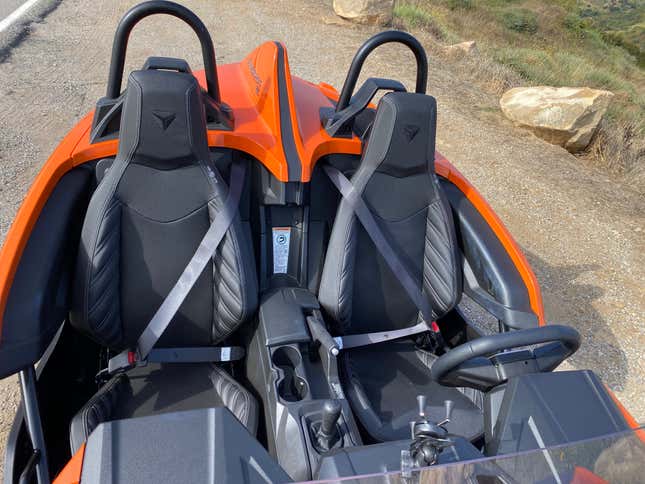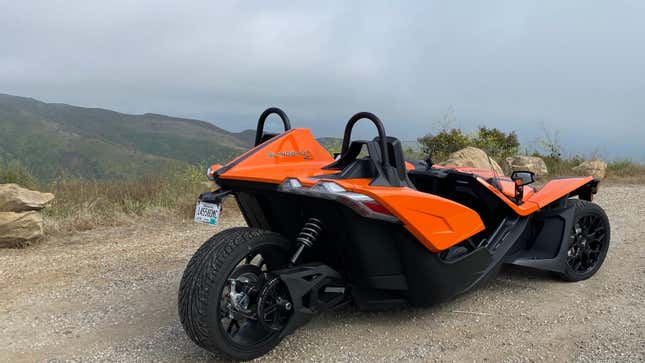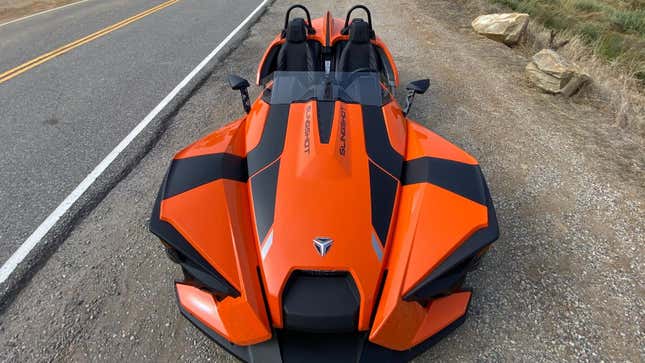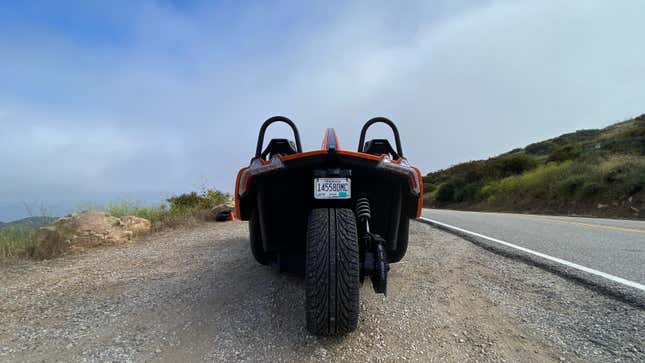Jalopnik is more than just a car blog. We discuss and review all kinds of transportation, from Boats Unpleasant trains Unpleasant motorcyclesbut this review is about something much more vague: The Polaris Catapult. You know, that three-wheeled, two-seater, open tricycle thing with a single belt-driven rear wheel. My concerns were high before I rode this Volt Orange 2024 Polaris Catapult SL, and after living with the Slingshot for a week, those concerns were confirmed. Catapult is really not for me.
Full disclosure: I’ve seen Polaris Slingshots terrorize people the streets of LA for years, and I can honestly say I never thought I would ever be riding one, but the generous folks at Polaris changed that. They loaned me a Volt Orange 2024 Polaris Slingshot SL with a 5-speed manual transmission and two helmets, and so it went.

To jump into the Slingshot, you must step over the tube frame structure on the side of the vehicle, there are no doors. Once you’re settled into the seat, there’s a surprising amount of legroom, almost enough for my 6-foot-3 frame to fit comfortably. Almost. Headroom obviously isn’t an issue since there’s no roof over your head, but since Polaris requires everyone who drives one of its press cars to wear a helmet, I didn’t get the wind-in-your-hair feeling that I, as a convertible enthusiast, had hoped for. Oddly enough, both of the Slingshot’s seat belts are anchored in the middle of the vehicle, so the driver has to reach over their right shoulder to grab the belt and fasten it to their left. This decision, combined with the lack of doors and insufficient seat bolsters, adds to the already perilous feeling of driving a Polaris.

Driving the Slingshot through LA is a stressful experienceas evidenced by my Whoop fitness watch, which records all my rides as moments of heightened stress. You sit very low to the ground, with no airbags, no doors, no roof. The engine is as sloppy as can be, but is limp all the way to the 8,500 rpm redline, where it finally makes its full power. The clutch is stiff and heavy, the transmission tunnel gets disconcertingly hot as you ride, the ride is harsh, and because the Slingshot is such an unusual shape, it’s hard to tell where the vehicle starts and where it ends. All of these factors, combined with the knowledge that one of the three-row mother cars on the roads of Los Angeles could run me over without me noticing, contributed to my heightened stress level behind the Slingshot’s small wheel.
The North StarThe Slingshot SL’s 2.0-liter inline-4 engine is rated at 178 horsepower and just 120 pound-feet of torque, the latter of which peaks at 5,500 rpm, and the Slingshot weighs just 1,633 pounds overall, nearly 1,000 pounds lighter than a Mazda Miata. That should make it a ton of fun to drive, but once the power ramps up, it’s only turning that single driven rear wheel, which can make you smile if you don’t need to hook it up. And it’s far from fast, and the engine’s behavior is contradictory. You have to rev it all the way to redline to get any power, but the engine is so clattery that it sounds like it’s going to explode. I also wasn’t a fan of the exhaust note, which sounded more like a leaf blower than a car. That might be justifiable in a side-by-side, but not in a car that’s meant to be a fun-to-drive machine.

Driving the Slingshot on winding roads was also a terrifying experience. My favorite canyon road had occasional debris, causing the Slingshot to lose traction no matter how slowly I was going. In one instance, there was a small strip of dirt in the middle of my lane on a curve; I slowed to 10 mph and nearly slid off the cliff because the rear wheel hit the dirt and lost a huge amount of traction. Thankfully, the Slingshot does have traction control and ABS, but the single rear wheel makes it too unpredictable to be reliable enough to push around twisty mountain roads. It’s also unreasonably difficult to gauge the width of the thing, because the front is insanely wide and the rear is insanely narrow, so threading the needle becomes an exercise in faith and elevated cortisol levels.
My tester came with the free 5-speed gearbox, which made the driving experience more appealing, but still had its flaws. The transmission is jerky and shifts well, but the high-revving nature of the Polaris engine doesn’t work well with the gear ratios. First to second gear is fine, but when you shift to third, the revs drop so drastically that you immediately drop out of the power band and the car bogs down.

“How about a cruise on the world famous Highway along the Pacific coast,” you might ask, “if it’s not good in the corners, is it even a good cruiser?” No, it isn’t. There’s never a moment when you can relax behind the wheel of the Slingshot. The rear wheel feels like it’s constantly bouncing around, forcing you to endlessly steer it to keep it centered in the lane. Wearing a helmet makes the cruising experience even less relaxing. If you get stuck in traffic, you’ll be cooking in the sun, exhausted by stinking exhaust, and your left leg will cramp from the heavy clutch.
The seats on my tester were heated and cooled, which is a welcome option. Unfortunately, when combined with Seat belts With the seats strapped into the center of the vehicle rather than across the occupants’ outer shoulder like in every other car, I felt like I was going to slide out of the Slingshot at every turn. Other conveniences include Apple CarPlay, which requires a Bluetooth headset to be connected to operate, so I never tried it.

My test vehicle was equipped with minimal options, including heated and cooled seats for $1,629.99, a phone holder for $100, and a navigation and CarPlay package, bringing the total MSRP to $30,428.97. The least expensive new Slingshot S retails for $21,999 without options, and the most expensive Slingshot Roush Edition starts at $38,149 without options. In my opinion, there are far better ways to spend $30,000, like getting hair plugs and a facelift as an alternative way to prove to the world you’ve still got it, or buying a used sports car, or $30,000 in lottery tickets.
Overall, I’m not a fan of the Polaris Slingshot, but I don’t think I’m the target audience either. What’s the target audience, you might ask? It’s a mystery to me, but people buy them and seem to love them, so if you cringe when you see a Slingshot drive by, try one. There’s absolutely nothing like the experience of driving a Polaris Slingshot, for better or for worse.



